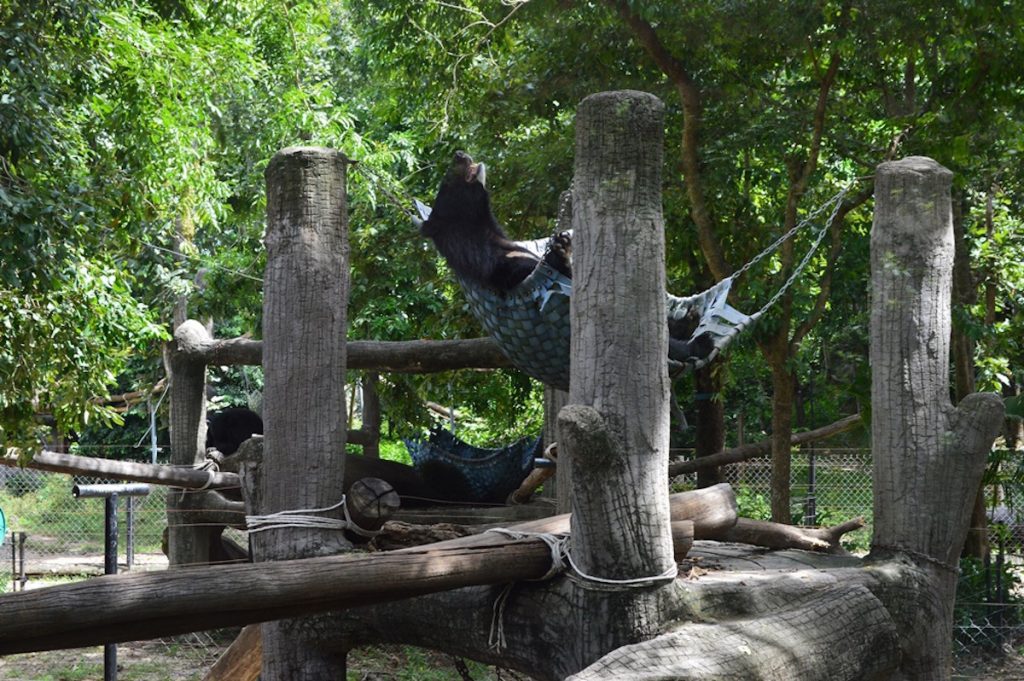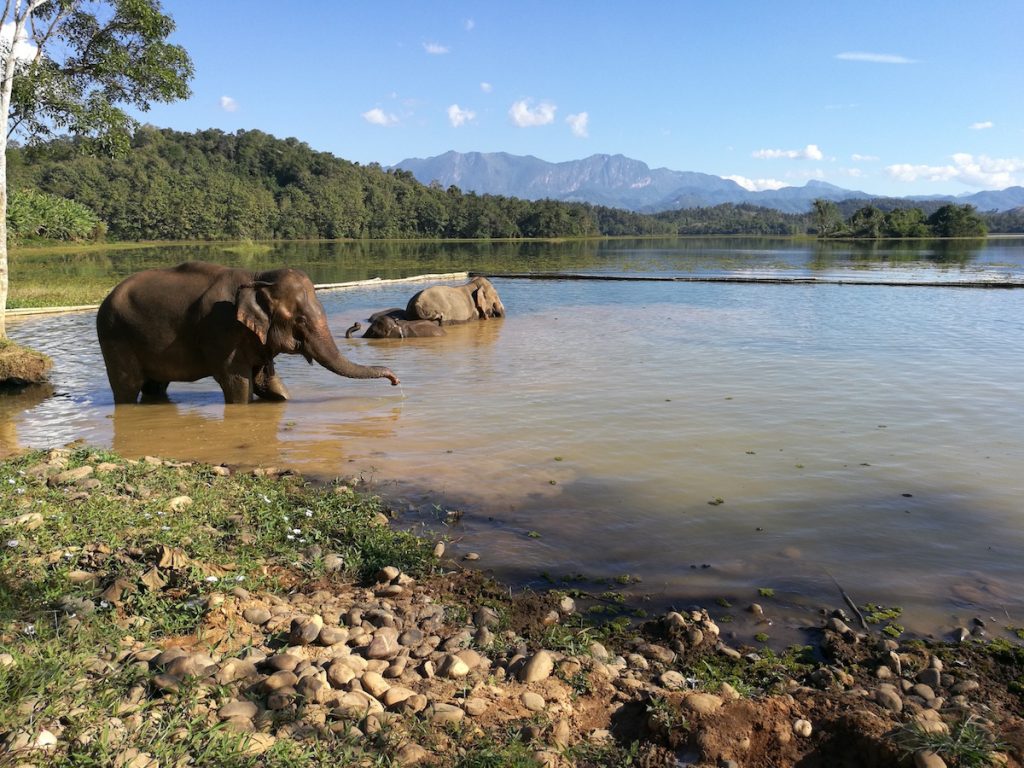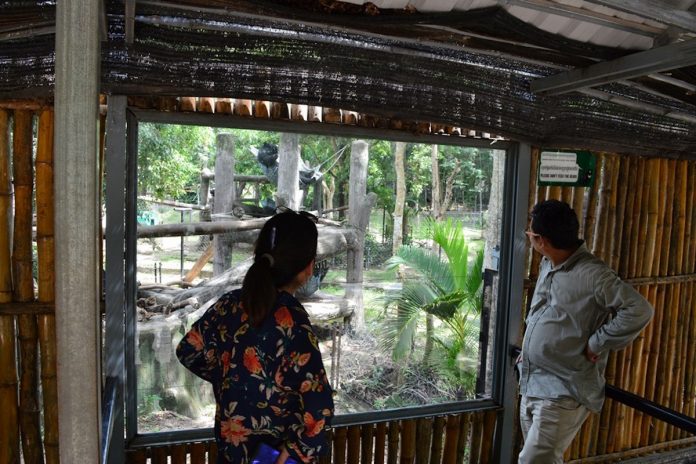At the Phnom Thmao Wildlife Rescue Center two bears Kong and Ralph rested in the early afternoon sun. A small group of visitors were watching them, hoping they would soon become a little more active.
It was another quiet day at the Free the Bears section of the center which is the home for 121 rescued sun and moon bears. With COVID-19 there are no foreign tourists in Cambodia, and now only Cambodian families and a few expats drive the one hour to Phnom Thmao from Phnom Penh to visit.
Free the Bears and the Phnom Thmao Wildlife Rescue Centerare among the big and small organizations working hard to protect nature and wildlife in Southeast Asia. Some of them have set up large nature reserves where endangered animals can lead a life without too many dangers. Others have set up a sanctuary for bears or elephants that were rescued from poachers and traffickers.
Many of these organizations largely rely on income generated from the millions of tourists that normally visit Southeast Asia, but the pandemic has changed that, and its impact is severe. With no foreign visitors, animal protectors now fear for the survival of their organizations. Experts warn that wildlife is now more endangered than it was before the pandemic.
Free the Bears manager Khuoy Pesei was standing near Kong’s and Ralph’s large cage when she was talking with LiCAS.news. She estimated that since early March the number of visitors has declined by 90 percent. Volunteers now can also no longer make it to the center, because most of them were foreign tourists visiting Cambodia.
“Currently we can only do what is absolutely necessary, such as feeding and caring of the bears,” Pesei said. “Other things, like maintenance, have to wait.”
Free the Bears’ other rescue centers in Vietnam and Laos are likewise being affected.

In the Asia-Pacific region wildlife tourism accounts for about US $53.3 billion of the regional Gross Domestic Product while providing some 4.5 million jobs, according to data from the World Travel & Tourism Council (WTTC). The WTTC said that this form of tourism is five times more valuable than the illegal wildlife trade.
Free the Bears has estimated that because of COVID-19 it has missed between 200,000 and 250,000 international tourists.
Free the Bears spokesperson Rod Mabin Vital said: “We’re not a wealthy charity and have trouble getting by each month. To lose all of our visitor revenue in one go is a massive blow.”
Meanwhile the Banteay Srey Butterfly Centre, near the Angkor temples in Siem Reap, has felt the impact of COVID-19 as well. Having a live display of Cambodian butterflies, the center normally attracts about 20,000 tourists per year. The subsequent revenue is used for conservation and education projects, as well as to support local communities, said the center’s director Ben Hayes.
But with no foreign tourists, the income went from “reasonably healthy to zero,” Hayes said. “Our managing staff are now working on reduced rates,” he said.
Hayes told LiCAS.news that the center’s research and conservation work has come to a hold.
He estimated that his organization will have enough funds to survive another five to six months, but it’s impossible to say what’s going to happen after that.
“There’s a lot of uncertainty and there are a lot of travel restrictions,” he said. “We know there’s not going to be a quick turnaround and tourism won’t come back for a while, but we try to hold on as long as we can.”
Impacting local communities
The consequences of tourism imploding in Cambodia also means that there’s less money for the protection of wildlife and for local communities dependent on the industry; these communities face falling back into poverty and could turn to poaching or illegal logging to make ends meet, experts have warned.
According to David Newsome, an associate professor at the Murdoch University in Australia, wildlife and nature projects all over the world are feeling the negative impact of COVID-19.
Newsome said that with many nature reserves and wildlife conservation projects depending on tourism fees, jobs are being be cut which could mean, for example, a reserve will have less rangers to keep poachers away.
“I’m afraid to say it, but it has put conservation and wildlife at risk,” Newsome said. If the coronavirus continues to wreak havoc in the tourism industry, things could take a very grim turn, he said.
“If the pandemic drags on to 2022, 2023, I’m convinced that there will be less gorillas, less forest and less spectacular birds in Asia because tourism helps to value and protect those species.”

However, that doesn’t mean the world needs to return to mass tourism to save wildlife, Newsome said. There are parts in the world where nature is reviving now that massive tourist crowds are gone. “It’s a double-edged sword, but my personal view is that the lack of tourism is more of a threat,” he said.
At the Elephant Conservation Center (ECC), in northwest Laos, they know all about it. The 6,000 hectares large reserve is home to 34 elephants. ECC founder Sébastien Duffillot said that his organization has lost 80 to 85 percent of its revenue.
“It’s a huge challenge but luckily we can continue our conversation work and our research, because that depends more on institutional funds than on tourism revenues,” Duffillot said.
The ECC founder said that his organization had to cut all salaries by at least 40 percent and with the return of tourism being uncertain, the sanctuary had no other option than to reinvent itself. “We will have more focus on local tourism but also on education, in bringing more classes to our sanctuary,” he said.
The ECC launched a crowdfunding campaign to make up the loss of revenue, which so far generated over US$37,000. “It helps, but it won’t allow us to go back to normal,” Duffillot said.
Free the Bears also had to be creative to make up for the loss of income. Rod Mabin said that they raised money with its ‘A night in a cage’ campaign, during which over 50 people sat one night in a small bear cage to raise money.
“We raised over AUD$80,000 (about US$57,000) which covered our bear food costs for May and June. Even our 82-year-old founder and our CEO spent a night in a cage,” he said.
Mabin said that his organization is incredibly grateful for the support, but just as with many other wildlife organizations, the struggle is far from over. “We’ve tried to adapt as quickly as we can, and we certainly hope we’ll be able to survive this crisis,” he said.









